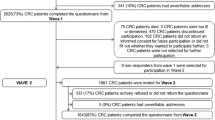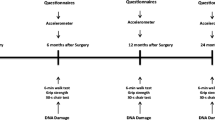Abstract
Objective
Increasing age and cancer history are related to impaired physical function. Since physical activity has been shown to ameliorate age-related functional declines, we evaluated the association between physical activity and function in older, long-term colorectal cancer survivors.
Methods
In 2006–2007, mailed surveys were sent to colorectal cancer survivors, aged ≥65 years when diagnosed during 1995–2000, and identified through a state cancer registry. Information on physical activity, physical function, and relevant covariates was obtained and matched to registry data. Analysis of covariance and linear regression were used to compare means and trends in physical function across levels of activity in the final analytic sample of 843 cases.
Results
A direct, dose-dependent association between physical activity and function was observed (p trend < .001), with higher SF-36 physical function subscores in those reporting high versus low activity levels (65.0 ± 1.7 vs. 42.7 ± 1.7 (mean ± standard error)). Walking, gardening, housework, and exercise activities were all independently related to better physical function. Moderate–vigorous intensity activity (p trend < .001) was associated with function, but light activity (p trend = 0.39) was not.
Conclusion
Results from this cross-sectional study indicate significant associations between physical activity and physical function in older, long-term colorectal cancer survivors.
Similar content being viewed by others
References
Centers for Disease Control (2004) Cancer Survivorship—United States, 1971–2001. MMWR 53:526–529
National Cancer Institute Office of Cancer Survivorship (2004). http://dccps.nci.nih.gov/ocs/ocs_factsheet.pdf
American Cancer Society (2006) Cancer facts and figures 2006. American Cancer Society, Atlanta
Hewitt M, Rowland J, Yancik R (2003) Cancer survivors in the United States: age, health, and disability. J Gerontol Med Sci 58:82–91
Demark-Wahnefried W, Aziz N, Rowland J, Pinto B (2005) Riding the crest of the teachable moment: promoting long-term health after the diagnosis of cancer. J Clin Oncol 23:5814–5830. doi:10.1200/JCO.2005.01.230
Sweeney C, Schmitz K, Lazovich D, Virnig B, Wallace R, Folsom A (2006) Functional limitations in elderly female cancer survivors. J Natl Cancer Inst 98:521–529
Schroevers M, Ranchor A, Sanderman R (2006) Adjustment to cancer in the 8 years following diagnosis: a longitudinal study comparing cancer survivors with healthy individuals. Social Sci Med 63:598–610. doi:10.1016/j.socscimed.2006.02.008
Ramsey S, Andersen M, Etzioni R, Moinpour C, Peacock S, Potosky A, Urban N (2000) Quality of life in survivors of colorectal carcinoma. Cancer 88:1294–1303. doi:10.1002/(SICI)1097-0142(20000315)88:6<1294::AID-CNCR4>3.0.CO;2-M
Given B, Given C, Azzouz F, Stommel M (2001) Physical functioning of elderly cancer patients prior to diagnosis and following initial treatment. Nurs Res 50:222–232. doi:10.1097/00006199-200107000-00006
Given C, Given B, Azzouz F, Stommel M, Kozachik S (2000) Comparison of changes in physical functioning of elderly patients with new diagnoses of cancer. Med Care 38:482–493. doi:10.1097/00005650-200005000-00005
Chirikos T, Russell-Jacobs A, Jacobsen P (2002) Functional impairment and the economic consequences of female breast cancer. Women Health 36:1–20
Keating N, Nørredam M, Landrum M, Huskamp H, Meara E (2005) Physical and mental health status of older long-term cancer survivors. J Am Geriatr Soc 53:2145–2152. doi:10.1111/j.1532-5415.2005.00507.x
Kurtz M, Kurtz J, Stommel M, Given C, Given B (1997) Loss of physical functioning among geriatric cancer patients: relationships to cancer site, treatment, and comorbidity and age. Eur J Cancer 33:2352–2358. doi:10.1016/S0959-8049(97)00323-7
Ganz P, Kwan L, Stanton A, Krupnick J, Rowland J, Meyerowitz B, Bower J, Belin T (2004) Quality of life at the end of primary treatment of breast cancer: first results from the moving beyond cancer randomized trial. J Natl Cancer Inst 96:376–387
Ganz P, Desmond K, Leedham B, Rowland J, Meyerowitz B, Belin T (2002) Quality of life in long-term, disease-free survivors of breast cancer: a follow-up study. J Natl Cancer Inst 94:39–49
Mols F, van de Poll-Franse L, Vinberhoets A, Hendrikx A, Aaronson N, Houterman S, Coebergh J, Essink-Bot M (2006) Long-term quality of life among Dutch prostate cancer survivors: results of a population-based study. Cancer 107:2186–2196. doi:10.1002/cncr.22231
Anthony T, Jones C, Antoine J, Sivess-Franks S, Turnage R (2001) The effect of treatment for colorectal cancer on long-term health-related quality of life. Ann Surg Oncol 8:44–49. doi:10.1007/s10434-001-0044-2
US Department of Health and Human Services (2008) Physical activity guidelines for Americans. US Department of Health and Human Services, Washington, DC
Visser M, Simonsick E, Colbert L, Brach J, Rubin S, Kritchevsky S, Newman A, Harris T, for the Health ABC Study (2005) Type and intensity of activity and risk of mobility limitation: the mediating role of muscle parameters. J Am Geriatr Soc 53:762–770. doi:10.1111/j.1532-5415.2005.53257.x
Cress M, Buchner D, Questad K, Esselman P, deLateur B, Schwartz R (1999) Exercise: effects on physical functional performance in independent older adults. J Gerontol A Biol Med Sci 54:M242–M248
Brach J, Simonsick E, Kritchevsky S, Yaffe K, Newman A, for the Health AaBCSRG (2004) The association between physical function and lifestyle activity and exercise in the health, aging and body composition study. J Am Geriatr Soc 52:502–509. doi:10.1111/j.1532-5415.2004.52154.x
Kendall A, Mahue-Giangreco M, Carpenter C, Ganz P, Bernstein L (2005) Influence of exercise activity on quality of life in long-term breast cancer survivors. Qual Life Res 14:361–371. doi:10.1007/s11136-004-1468-5
Demark-Wahnefried W, Clipp E, Morey M, Pieper C, Sloane R, Snyder D, Cohen H (2004) Physical function and associations with diet and exercise: results of a cross-sectional survey among elders with breast or prostate cancer. Int J Behav Nutr Phys Act 1:16
Demark-Wahnefried W, Clipp E, Morey M, Pieper C, Sloane R, Clutter Snyder D, Cohen H (2006) Lifestyle intervention development study to improve physical function in older adults with cancer: outcomes from Project LEAD. J Clin Oncol 24:3465–3473. doi:10.1200/JCO.2006.05.7224
Courneya K, Mackey J, Bell G, Jones L, Field C, Fairey A (2003) Randomized controlled trial of exercise training in postmenopausal breast cancer survivors: cardiopulmonary and quality of life outcomes. J Clin Oncol 21:1660–1668. doi:10.1200/JCO.2003.04.093
Segal R, Evans W, Johnson D, Smith J, Colletta S, Gayton J, Woodard S, Wells G, Reid R (2001) Structured exercise improves physical functioning in women with stages I and II breast cancer: results of a randomized controlled trial. J Clin Oncol 19:657–665
Courneya K, Friedenreich C, Quinney H, Fields A, Jones L, Fairey A (2003) A randomized trial of exercise and quality of life in colorectal cancer survivors. Eur J Cancer Care 12:347–357. doi:10.1046/j.1365-2354.2003.00437.x
McKenzie D, Kalda A (2003) Effect of upper extremity exercise on secondary lymphedema in breast cancer patients: a pilot study. J Clin Oncol 21:463–466. doi:10.1200/JCO.2003.04.069
Herrero F, San Juan A, Fleck S, Balmer J, Pérez M, Cañete S, Earnest C, Foster C, Lucía A (2006) Combined aerobic and resistance training in breast cancer survivors: a randomized, controlled pilot trial. Int J Sports Med 27:573–580. doi:10.1055/s-2005-865848
Basen-Engquist K, Carmack Taylor C, Rosenblum C, Smith M, Shinn E, Greisinger A, Gregg X, Massey P, Valero V, Rivera E (2006) Randomized pilot test of a lifestyle physical activity intervention for breast cancer survivors. Patient Educ Couns 64:225–234. doi:10.1016/j.pec.2006.02.006
Courneya K, Friedenreich C (1999) Physical exercise and quality of life following cancer diagnosis: a literature review. Ann Behav Med 21:171–179. doi:10.1007/BF02908298
Stevinson C, Lawlor D, Fox K (2004) Exercise interventions for cancer patients: systematic review of controlled trials. Cancer Causes Control 15:1035–1056. doi:10.1007/s10552-004-1325-4
Singh M (2004) Exercise and aging. Clin Geriatr Med 20:201–221. doi:10.1016/j.cger.2004.03.003
Roubenoff R, Hughes V (2000) Sarcopenia: current concepts. J Gerontol A Biol Med Sci 55:M716–M724
Doherty T (2001) The influence of aging and sex on skeletal muscle mass and strength. Curr Opin Clin Nutr Metab Care 4:503–508. doi:10.1097/00075197-200111000-00007
Hawkins S, Wiswell R (2003) Rate and mechanism of maximal oxygen consumption decline with aging: implications for exercise training. Sports Med 33:877–888. doi:10.2165/00007256-200333120-00002
Stewart A, Mills K, King A, Haskell W, Gillis D, Ritter P (2001) CHAMPS physical activity questionnaire for older adults: outcomes for interventions. Med Sci Sports Exerc 33:1126–1141. doi:10.1097/00005768-200107000-00010
Harada N, Chiu V, King A, Stewart A (2001) An evaluation of three self-report physical activity instruments for older adults. Med Sci Sports Exerc 33:962–970. doi:10.1097/00005768-200106000-00016
Reulen R, Zeegers M, Jenkinson C, Lancashire E, Winter E, Jenney M, Hawkins M (2006) The use of the SF-36 questionnaire in adult survivors of childhood cancer: evaluation of data quality, score reliability, and scaling assumptions. Health Qual Life Outcomes 4:77. doi:10.1186/1477-7525-4-77
Mosconi P, Cifani S, Crispino S, Fossati R, Apolone G (2000) The performance of SF-36 health survey in patients with laryngeal cancer. Head and neck cancer Italian working group. Head Neck 22:175–182. doi:10.1002/(SICI)1097-0347(200003)22:2<175::AID-HED10>3.0.CO;2-V
Pinar R (2005) Reliability and construct validity of the SF-36 in Turkish cancer patients. Qual Life Res 14:259–264. doi:10.1007/s11136-004-2393-3
Ware JJ, Snow K, Kosinski M, Gandek B (1993) SF-36 health survey manual and interpretation guide. The Health Institute, New England Medical Center, Boston, MA
Ware JJ, Kosinski M, Keller S (1994) SF-36 physical and mental health summary scales: a user’s manual. Health Assessment Lab, New England Medical Center, Boston, MA
Ware JJ, Sherbourne C (1992) The MOS 36-item short form health survey (SF-36): I. Conceptual framework and item selection. Med Care 30:473–483. doi:10.1097/00005650-199206000-00002
Pate R, Pratt M, Blair S, Haskell W, Macera C, Bouchard C, Buchner D, Ettinger W, Heath G, King A, Kriska A, Leon A, Marcus B, Morris J, Paffenbarger R Jr, Patrick K, Pollock M, Rippe J, Sallis J, Wilmore J (1995) Physical activity and public health. A recommendation from the centers for disease control and prevention and the American college of sports medicine. JAMA 273:402–407. doi:10.1001/jama.273.5.402
Arriaza Jones D, Ainsworth B, Croft J, Macera C, Lloyd E, Yusuf H (1998) Moderate leisure-time physical activity. Who is meeting the public health recommendations? a national cross-sectional study. Arch Fam Med 7:285–289. doi:10.1001/archfami.7.3.285
Trentham-Dietz A, Remington P, Moinpour C, Hampton J, Sapp A, Newcomb P (2003) Health-related quality of life in female long-term colorectal cancer survivors. Oncologist 8:342–349. doi:10.1634/theoncologist.8-4-342
Acknowledgments
Laura Stephenson and the staff of the Wisconsin Cancer Reporting System; Jane McElroy, Julie McGregor, John Hampton, and Maggie Perdzock of the UW Comprehensive Cancer Center Survey Research Shared Service; Masataka Umeda, LeeAnne Flygt and Ann Wiringa for assistance with data collection and entry. Support for this research was provided by the Aging and Cancer Program, Paul P. Carbone Comprehensive Cancer Center, University of Wisconsin through NIH grant numbers P20 CA103697 and P30 CA14520.
Author information
Authors and Affiliations
Corresponding author
Rights and permissions
About this article
Cite this article
Johnson, B.L., Trentham-Dietz, A., Koltyn, K.F. et al. Physical activity and function in older, long-term colorectal cancer survivors. Cancer Causes Control 20, 775–784 (2009). https://doi.org/10.1007/s10552-008-9292-9
Received:
Accepted:
Published:
Issue Date:
DOI: https://doi.org/10.1007/s10552-008-9292-9




